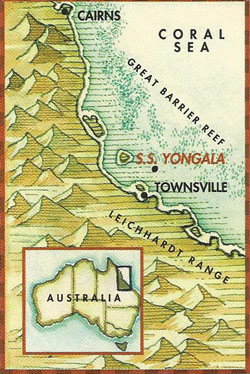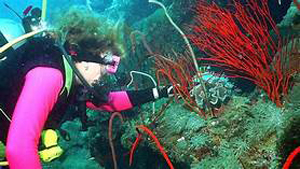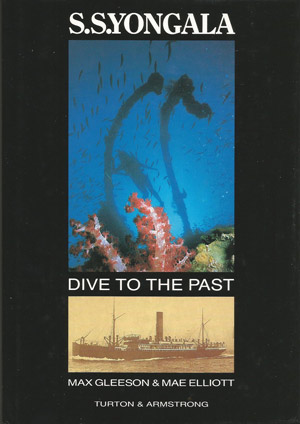‘Moonshine’ Not to Blame for Loss of SS Yongala
When vessels go down without a trace—no how, what, when or where recorded—they become “mystery ships.” Such was the case of the SS Yongala, a stately passenger and cargo steamship that disappeared March 24, 1911, off the coast of Queensland, Australia. There were no survivors. The 121 passengers and crew perished in a tragedy that became “Australia’s most famous shipwreck.”

Map shows where ship was lost off Queensland coast Credit: Bonnier Corp.
Named after a town in South Australia, the vessel was seven years old when the Adelaide Steamship Company put her in service on the Queensland coast. This was a busy trade route which included stops at smaller ports on regularly scheduled trips. Captain William Knight was experienced and highly respected in the maritime world. He was 48 years old when hired by the company’s president who called him, “A fine seaman totally concerned for the safety of his ship and its passengers.”
SS Yongala left Melbourne, bound for Cairns, on March 14 with scheduled stops along the way. One stop was Sydney where most of the passengers disembarked. Brisbane was the last port for the steamer before cruising north toward Townsville. She made a brief stop at Flat-Top Island on March 23, where freight and passengers were transferred to shore by small boats. Departing in the afternoon for the 208-mile trip to Townsville, the ship probably had about five hours of smooth sailing before running into strong winds and rough seas. That’s when a moderate gale became a raging storm. Without communication, the captain had no knowledge of the cyclone warnings that were sent along the coast. The wind increased to gusts of 70 mph. River and bay waters rose as the barometer dropped. If Capt. Knight had thought of seeking shelter earlier, it was too late now. The ship was steaming into the vortex of a cyclone that was battering the north Queensland coast.
When the weather finally calmed down, a quest began where no expense was spared in “Australia’s greatest maritime search.” The steamship company sent out two vessels and soon a government launch, a tugboat and two more steamships joined the hunt. The ship’s route was traced from Dent Island where the lighthouse keeper reported seeing it. Nares Rock and Halbourne Island, two dangerous spots, were scoured in addition to the reefs from Cape Cleveland to Cape Upstart. The launch Tivola searched along the coast all the way up to Halifax Bay. In three days, the intensive quest covered the inner fringe of the Great Barrier Reef and all bays and inlets. Landing parties searched the many offshore islands for survivors. The Queensland government offered one thousand dollars for information leading to the discovery of the mystery ship. Clues appeared when burlap bags full of chaff, bran and pumpkins turned up on Lighthouse Beach at Cape Bowling Green. More remains were found north of the cape including bedding, a mail bag and a broken glass door identified as being from the ship’s promenade deck The decomposing carcass of a horse, presumed to be Moonshine, was discovered on the beach. When the search culminated, local newspapers declared the steamship sunk with no survivors.

Diver inspects prolific marine life on the wreck, Credit: Townsville Museum

SS Yongala: Dive to the Past captures the whole story of “Australia’s most famous shipwreck”, Credit: Turton & Armstrong Pub. Co.
Listed on charts as an artificial reef, the 363-foot steamer rests on its starboard side in 90 feet of crystal clear waters. It presents a biodiverse ecosystem like no other in the Great Barrier Reef Marine Park. To this day, a medley of marine life provides an infinite venue for the aging vessel. Divers rave over the prolific marine organisms and fascinating “critters” that call it home. Jumbo trevally, ominous looking members of the jack family, feed on schools of silversides at the forecastle. Three-foot-long Maori wrasse hang motionless amidship. Massive potato cod show no fear as they follow divers across the main deck. Eagle rays cruise the promenade deck, while blacktip sharks and hawksbill turtles favor the quarterdeck where hawsers lay across rusting metal plates. A mélange of multicolored tropical fish cluster in “hot spots” where plankton and algae begin the food chain. Many varieties of stony coral colonies and gorgonians, surrounded by colorful sea anemones and sponges, have taken root throughout the wreck. Although many years have passed, key roles of subsistence are perpetually played by the occupants of this rare habitat in the Coral Sea.
Life continues beneath the waters, while the fate of the SS Yongala passes beyond human perception into the realm of conjecture. It remains a major story in Australia’s maritime history and one more entry on the docket of mysteries from the sea.
Author: Ellsworth Boyd
Ellsworth Boyd, Professor Emeritus, College of Education, Towson University, Towson, Maryland, pursues an avocation of diving and writing. He has published articles and photo’s in every major dive magazine in the US., Canada, and half a dozen foreign countries. An authority on shipwrecks, Ellsworth has received thousands of letters and e-mails from divers throughout the world who responded to his Wreck Facts column in Sport Diver Magazine. When he’s not writing, or diving, Ellsworth appears as a featured speaker at maritime symposiums in Los Angeles, Houston, Chicago, Ft. Lauderdale, New York and Philadelphia. “Romance & Mystery: Sunken Treasures of the Lost Galleons,” is one of his most popular talks. A pioneer in the sport, Ellsworth was inducted into the International Legends of Diving in 2013.
6 Comments
Submit a Comment
All Rights Reserved © | National Underwater and Marine Agency
All Rights Reserved © | National Underwater and Marine Agency
Web Design by Floyd Dog Design
Web Design by Floyd Dog Design

I enjoyed the article about the SS Yongala and how the horse, Moonshine, got blamed for the loss of the ship and everyone aboard. I’m wondering why the captain left port when there were storms brewing?
Storms are not uncommon along the Queensland coast. When the SS Yongala started out, the weather was okay, but then a gale came up. Usually, in a case like this, ships are able to find shelter at a port along the coast Unfortunately, the gale rapidly became a cyclone and as visibility dropped to zero, the wind and waves kicked up and took the Yongala down.
Very interesting article and well written. Thanks.
Thank you, Harry. This was a fascinating ship to research. The Moonshine story was sort of silly, bu some people believed it. When the SS Yongala ran into the cyclone, there wasn’t much the captain could do. It was zero visibility in horrible sea conditions.
Very interesting article. I would dare say that the people who piloted the ship were a little suspicious of anything out of the ordinary, and apparently having a horse on board was more than their feeble minds could handle. It is sad that the tragedy happened, but sometimes it can be chalked up to human error, unfortunately. The weather is not something that anybody wants to mess with, no matter how experienced they think they are. Again, though, I do appreciate the historicity of this article.
Yes, the weather which is so important to monitor, can do them all in. I think sometimes the captains, knowing there’s bad weather coming, leave port anyway. Either they think they can outrun the coming storm or they underestimate the prediction. A “light gale,” for instance, can turn into a storm so severe, a ship can’t maneuver in it. Thanks for writing to Numa.net.